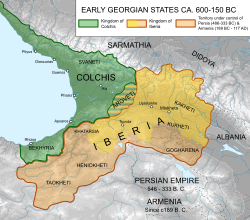Kingdom of Iberia
| Kingdom of Iberia | ||||||||||||
| ქართლის სამეფო kartlis samepo |
||||||||||||
| Vassal of the Seleucid Empire (302–159 BC), the Roman Republic (65–63 BC, 36–32 BC), the Roman Empire (1–117 AD), the Byzantine Empire (298-363 AD). Tributary state of Sassanid Persia (252-272 AD), vassal state of Sassanid Persia (363 AD-482 AD, 502-523 AD). Direct Sassanid Persian rule (523-580 AD). |
||||||||||||
|
||||||||||||
|
|
||||||||||||
|
Colchis and Iberia
|
||||||||||||
| Capital |
Armazi Mtskheta Tbilisi |
|||||||||||
| Languages | Georgian | |||||||||||
| Government | Monarchy | |||||||||||
| Historical era | Antiquity | |||||||||||
| • | Pharnavaz I's reign | ca. 302 BC | ||||||||||
| • | Christianization of Iberia during reign of Mirian III | 326 ? AD/337 ? AD | ||||||||||
| • | Direct Sasanian control and abolishment of the monarchy. | 580 AD | ||||||||||
|
||||||||||||
| Today part of |
|
|||||||||||

Flag of the kingdom after Christianization of Iberia in an early 4th century
In Greco-Roman geography, Iberia (Ancient Greek: Ἰβηρία; Latin: Hiberia) was an exonymic name for a Georgian kingdom of Kartli (Georgian: ქართლი), known after its core province, which during Classical Antiquity and the Early Middle Ages was a significant state in the Caucasus, either as an independent state or as a dependent of larger empires, notably the Sassanid and Roman empires. Iberia, centered on present-day Eastern Georgia, was bordered by Colchis in the west, Caucasian Albania in the east and Armenia in the south. Its population, known as the Iberians, formed the nucleus of the Georgians (Kartvelians). Iberia, ruled by Pharnavazid, Arsacid and Chosroid royal dynasties, together with Colchis to its west, would form the nucleus of the unified medieval Kingdom of Georgia under Bagrationi dynasty.
...
Wikipedia

